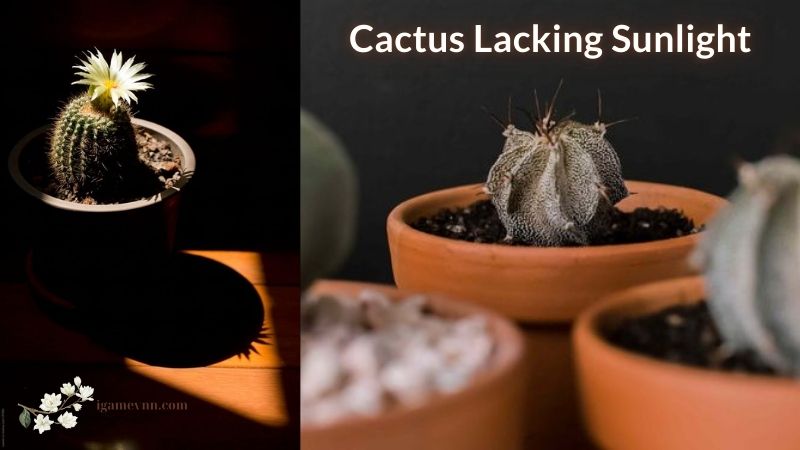Cacti are remarkable plants, renowned for their ability to thrive in some of the harshest, sunniest environments on Earth. Originating from arid regions, these resilient plants have adapted to store water efficiently and withstand intense sunlight. However, what happens when a cactus lacking sunlight? This article from Igamevnn delves into the effects of insufficient sunlight on cacti, the signs to look out for, and how to remedy the situation to ensure your cactus thrives.
Table of Contents
ToggleThe Importance of Sunlight for Cacti
Sunlight is a crucial factor for the health and growth of cacti. These plants are adapted to environments with high light intensity, and sunlight plays a vital role in photosynthesis, the process by which they convert light energy into chemical energy to fuel their growth. When cactus lacking sunlight, it can lead to several issues that affect its overall health and appearance.

Signs of a Cactus Lacking Sunlight
-
Etiolation
One of the most common signs that a cactus lacking sunlight is etiolation. Etiolation is a process where the plant stretches and grows taller as it tries to reach more light. This results in an elongated, thinner appearance, which is quite different from the robust and compact structure typically seen in healthy cacti. If you notice your cactus growing unusually tall and slender, it’s likely a sign of insufficient light.
-
Pale Color
Cacti that do not receive enough sunlight often develop a pale or yellowish tint. This color change occurs because the plant is not getting enough light for proper photosynthesis. Inadequate light can hinder the production of chlorophyll, the pigment responsible for the green color in plants. Consequently, the cactus may lose its vibrant green hue, becoming pale and unhealthy-looking.

-
Slow Growth
A cactus lacking sunlight will exhibit significantly slower growth. Sunlight is essential for photosynthesis, which provides the energy necessary for growth. Without sufficient light, the plant’s metabolic processes slow down, resulting in stunted growth. If your cactus seems to be growing at a snail’s pace, it’s likely due to a lack of adequate sunlight.
-
Weak Structure
Another consequence of insufficient sunlight is a weakened plant structure. When a cactus lacks sunlight, its tissues may not develop properly, making the plant more susceptible to diseases and pests. A weak cactus may have a softer, less rigid feel, and its spines might not be as sharp or robust as those of a healthy cactus.
-
Decreased Flowering
Many cacti are prized for their beautiful and often spectacular flowers. However, flowering requires a considerable amount of energy, which can only be produced through adequate sunlight. When cactus lacking sunlight, it may not have the energy reserves necessary to produce flowers, leading to decreased or absent blooming.
Addressing the Lack of Sunlight
If you suspect that your cactus lacking sunlight, there are several steps you can take to improve its condition and ensure it receives the light it needs.
Moving to a Brighter Location
The simplest and most effective solution is to move your cactus to a brighter location. Ideally, place it where it can receive several hours of direct sunlight each day. South-facing windows are usually the best spots for indoor cacti, as they get the most sunlight throughout the day. If moving the cactus outdoors, ensure it is placed in a location with plenty of sunlight, but also be mindful of gradual exposure to avoid sunburn.

Using Artificial Grow Lights
In situations where natural sunlight is insufficient or inconsistent, artificial grow lights can be a lifesaver. Grow lights designed for succulents and cacti can provide the necessary light spectrum for healthy growth. Position the lights close to the cactus, ensuring they provide enough light intensity for several hours each day. This can help mitigate the effects of a cactus lacking sunlight and promote healthier growth.
Gradual Exposure to Light
If your cactus has been in a low-light environment for an extended period, sudden exposure to intense sunlight can cause sunburn or shock. To prevent this, gradually increase its exposure to light. Start by placing it in a slightly brighter location and slowly increase the amount of direct sunlight it receives over a few weeks. This gradual acclimatization helps the cactus adjust without experiencing stress.
Regular Monitoring
Regularly monitor your cactus to ensure it is receiving adequate sunlight. Observe its growth patterns, color, and overall health. If you notice any signs that indicate a cactus lacks sunlight, such as etiolation or pale color, take immediate action to provide more light. Consistent care and attention will help your cactus thrive in its environment.
Conclusion
Cacti are fascinating plants with unique adaptations that allow them to survive in extreme environments. However, when a cactus lacking sunlight, it can experience a range of issues that affect its health and appearance. From etiolation and pale color to slow growth and weak structure, the effects of insufficient sunlight can be detrimental. By recognizing the signs and taking proactive measures, such as moving the cactus to a brighter location or using artificial grow lights, you can ensure your cactus receives the light it needs to thrive.
Remember, a healthy cactus is one that enjoys plenty of sunlight. Regular monitoring and gradual adjustments can help maintain its vibrant green color, robust structure, and potential for beautiful blooms. With the right care and attention, your cactus can continue to be a stunning and resilient addition to your plant collection.
Related Posts:
- The World of Squash and Pumpkin: A Comprehensive Guide
- How to Fertilize NPK for Ornamental Plants: A…
- The Ultimate Guide to Greenhouse Vegetable Growing
- Chickens with Dark Crests: A Detailed Overview
- Which Chrysanthemum is Easy to Grow: A Comprehensive Guide
- Is Japanese Bamboo Poisonous? A Comprehensive Guide

